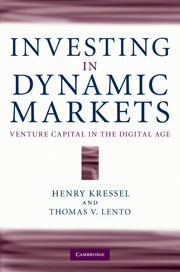Book contents
- Frontmatter
- Contents
- List of figures
- List of tables
- Acknowledgments
- Introduction
- 1 Hot markets, investment waves, bubbles, charlatans
- 2 Financing high-risk businesses
- 3 Venture investing: An uncertain science
- 4 Investing in a transformed market: Telecommunications
- 5 Investing in a transformed market: Semiconductors
- 6 Investing in early-stage technology: The Internet in the 1990s
- 7 Software products and services
- 8 Venture capital: Past and future
- Appendix
- Bibliography
- Index
8 - Venture capital: Past and future
Published online by Cambridge University Press: 06 July 2010
- Frontmatter
- Contents
- List of figures
- List of tables
- Acknowledgments
- Introduction
- 1 Hot markets, investment waves, bubbles, charlatans
- 2 Financing high-risk businesses
- 3 Venture investing: An uncertain science
- 4 Investing in a transformed market: Telecommunications
- 5 Investing in a transformed market: Semiconductors
- 6 Investing in early-stage technology: The Internet in the 1990s
- 7 Software products and services
- 8 Venture capital: Past and future
- Appendix
- Bibliography
- Index
Summary
The advancement of the arts, from year to year, taxes our credibility and seems to presage the arrival of that period when human improvement must end.
Henry L. Ellsworth, Commissioner of the Patent Office, 1843No, we have not seen the end of industrial innovations. In fact, the pace of technology development continues to accelerate, and the world depends on innovations to drive economic growth. New technologies continue to appear, promising to improve human health, accelerate business processes, open new avenues for renewable energy generation, or accomplish any number of other worthwhile missions.
Without risk capital many of the innovations of the past 40 years would have had a negligible impact on the economy. Throughout this book we have seen the crucial role that venture capital has played, particularly in the US, in funding innovative young companies that create new markets and new industries with their technology.
But the story is not wholly positive. For two decades, between 1980 and 2000, venture capital availability increased at a remarkable rate, giving venture capital firms (VCs) the means to finance all those startups. Then, with the bursting of the Internet and telecommunications investment bubbles, the environment changed. The capital available for investment by VCs declined from its peak of $104 billion in that year, as shown in Figure 2.1 (p. 44), to only $28 billion in 2008.
To make matters worse, during the same period there has been a marked reduction in the average financial returns of venture capital funds.
- Type
- Chapter
- Information
- Investing in Dynamic MarketsVenture Capital in the Digital Age, pp. 216 - 249Publisher: Cambridge University PressPrint publication year: 2010



